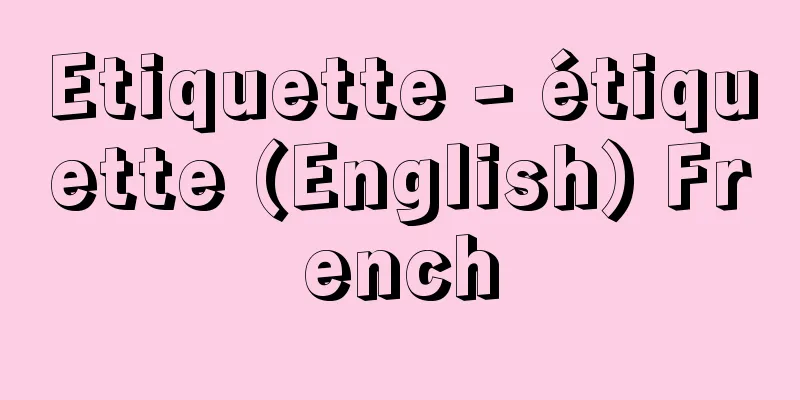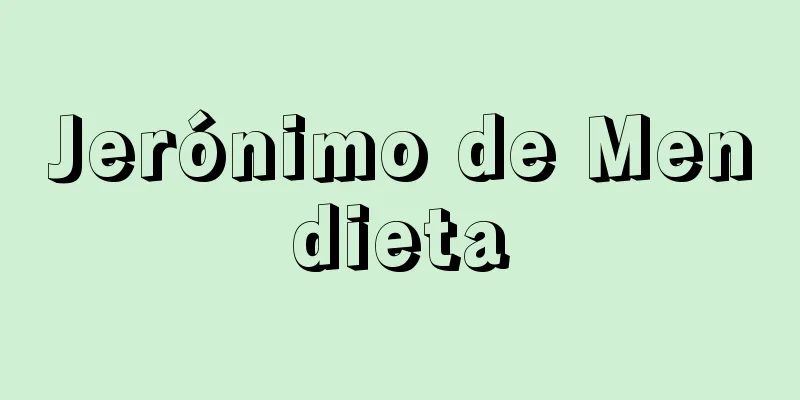Virgin Mary and Child

|
It refers to the Virgin Mary and the infant Jesus. According to the New Testament, Mary belonged to the House of David (Luke 1:27) and was betrothed to Joseph, but was conceived by the Holy Spirit and gave birth to Jesus. Christians believe that Jesus is the Savior, the only begotten Son of God incarnate. After the Third Council of Ephesus (431) dogmatically recognized Mary as the "Mother of God," veneration of Mary as the "Mother of God" rapidly spread within the Catholic Church. Because Mary is the person closest to God's Son, Jesus, people ask her to intercede for them. Because of this devotion, Mary and the infant came to be venerated as the Virgin Mary and Child. [Kadowaki Yoshiyoshi] Madonna and ChildOne of the icons in Christian art. It is a representation of the Virgin Mary holding the infant Jesus, but it is not a narrative scene, but a worship statue intended to reveal the divinity of the Virgin Mary as the Mother of God (Theotokos). It is considered to be an expression that appeared in Christian art after the proclamation of Mary's divinity at the Third Council of Ephesus in 431. There are examples of what appear to be Madonna and Child figures in the wall paintings of the catacombs (underground tombs) of Rome from the 3rd and 4th centuries, but there is no definitive proof. After the Council of Ephesus, the cult of the Virgin Mary was born in various places, and churches dedicated to Mary were built one after another. It is thought that Madonna and Child figures were also depicted on the wall, but no examples from the 5th century remain. From the 6th century onwards, Madonna and Child figures became more common in church wall paintings and icons. The basic forms of representation were the Hodigitria type, in which the Virgin Mary stands and holds Christ in her left arm, and the Nicopoia type, in which the Virgin Mary is seated and facing forward and holds Christ in her lap, and after the end of Iconoclasm in the 9th century, a wide variety of variations were created. In Byzantine art, the Madonna and Child portrayed the role of the solemn mother as a guide (hodigitria) and a victor (nikopoiia), whereas in Western art, the Madonna and Child portrayals emphasized Mary's human kindness, and a form was created in which Mary kneels and worships the infant Jesus. Some portray the Madonna as the "Madonna of Breastfeeding" or the "Madonna of Humility." The "Madonna of the Rose Hedge," with a hedge of white or red roses behind her, and the lily of the valley and violets placed as background flowers, also expressed the gentleness of the Virgin Mary and were symbols of paradise. Using these images as the womb, many Madonna and Child portrayals were created during the High Renaissance, with outdoor landscapes as the background. Representative examples include G. Bellini's "Madonna of the Meadow" (National Gallery, London), Raphael's "Madonna of the Hibiscus" (Uffizi Gallery), and Leonardo da Vinci's "Madonna of the Rocks" (Louvre Museum), and these Madonna and Child images in Italian art are often called "Madonnas." There are also depictions of the Virgin Mary and Jesus rubbing their cheeks together, but in Byzantine art, Mary wears an expression of deep sadness, as if she is worried about the fate of her child, while Jesus innocently rubs her cheek against him. In contrast, in Western art, the relationship is reversed, and the Virgin Mary and Mary are depicted as a mother, filled with compassion. [Natori Shiro] 1326 Tempera, Metropolitan Museum of Art Martini "Madonna and Child" Source: Shogakukan Encyclopedia Nipponica About Encyclopedia Nipponica Information | Legend |
|
聖母マリアと幼児イエスをいう。『新約聖書』によればマリアはダビデ家に属し(「ルカ伝福音(ふくいん)書」1章27節)、ヨセフと婚約したが聖霊によって懐胎し、イエスを産んだ。キリスト教信者はこのイエスが救い主であり、神の独子(ひとりご)が人となられた方であると信ずる。第3回エフェソス公会議(431)がマリアを「神の母」として教義的に公認して以後、カトリック教会では「神の母」マリアへの崇敬が急速に広まった。マリアは神の子イエスにもっとも近い方であるから、マリアに取次ぎを願うのである。この信心のために、マリアと幼児を聖母子として崇(あが)めるようになった。 [門脇佳吉] 聖母子像キリスト教美術の図像の一つ。幼児イエスを胸に抱いた聖母マリアの表現だが、物語場面ではなく、神の母(テオトコス)としての聖母マリアの神性顕示を目的とした礼拝像である。431年の第3回エフェソス公会議でのマリアの神性宣告ののち、キリスト教美術に登場した表現とみなされている。 3~4世紀のローマのカタコンベ(地下墓所)壁画にも聖母子像とおぼしき作例があるが、確証はない。エフェソス公会議ののち、各地に聖母崇拝が生まれ、マリアに捧(ささ)げられた教会が次々に建てられ、聖母子像も壁画に描かれていたと思われるが、5世紀の作例は現存しない。6世紀以降の教会壁画やイコンに聖母子像表現が盛んになる。その表現形式は、立像の聖母が左腕にキリストを抱きかかえるホディギトリア型、正面を向いた座像の聖母が膝(ひざ)にキリストを抱えるニコポイア型を基本型とし、9世紀のイコノクラスム(聖像破壊運動)終結後には、多彩なバリエーションが生まれた。 ビザンティン美術の聖母子像は、荘厳なる母の役割が導き手(ホディギトリア)、勝利者(ニコポイア)といった意味をもっていたのに対して、西欧の聖母子像はあくまでもマリアの人間的な優しさを強調したものが多く、マリアがひざまずいて幼児イエスを崇拝する形式も生まれた。「授乳の聖母」や「謙遜(けんそん)の聖母」などの内容を伝えるものもある。白や赤のバラの垣根を背にした「バラ垣の聖母」や、点景として配されるスズランやスミレの花なども聖母の優しさの表現であり、また、楽園の象徴でもあった。そして、これらの図像を母胎として、盛期ルネサンスには戸外の風景を背景とする聖母子像が多数つくられた。G・ベッリーニの『牧場の聖母』(ロンドン、ナショナル・ギャラリー)、ラファエッロの『鶸(ひわ)の聖母』(ウフィツィ美術館)、レオナルド・ダ・ビンチの『岩窟(がんくつ)の聖母』(ルーブル美術館)などはその代表的作例であり、これらイタリア美術における聖母子像はしばしば「マドンナ」Madonnaともよばれている。聖母とイエスが頬(ほお)をすり寄せる表現もあるが、ビザンティン美術ではマリアはわが子の運命を案ずるような深い悲しみの表情をたたえ、イエスは無邪気に頬をすり寄せている。これに対して、西欧美術ではその関係は逆転して、あくまでも慈しみに満ちた聖母、母たるマリアの表現になっている。 [名取四郎] 1326年ころ テンペラメトロポリタン美術館所蔵"> マルティーニ『聖母子』 出典 小学館 日本大百科全書(ニッポニカ)日本大百科全書(ニッポニカ)について 情報 | 凡例 |
>>: The Miracle Story of the Virgin Mary
Recommend
ODT - ODT
OpenDocument Text is a document file format. It is...
Khutbah (English spelling)
A sermon given by Muslims at Friday noon prayer or...
Rodo
Uruguayan writer and thinker. Born in the capital,...
"The Life of Madame Curie" - Curie Fujinden
During World War I, she organized medical activit...
Acacia senegal (English spelling) Acaciasenegal
…[Hiroshi Aramata]. … From [Gum Arabic] …It is a ...
Tāntia Topi (English spelling)
Around 1819-59 A military commander in the final d...
Pitti Gallery (English name: Galleria Palatina, Palazzo Pitti)
Located on the south side of the Arno River in Fl...
Pulszky Ferenc
Born: September 17, 1814. [Died] September 9, 1897...
Raw stone nose - Oishibana
Also called Iwaishizaki. A cape on the eastern edg...
Pine forest - Shorin
An industrial city in the northwest of North Hwan...
Onshi Zaidanboshi Aiikukai - Onshi Zaidanboshi Aiikukai
...Aiiku Mura was established as a social work fa...
Ryusei Kishida
Western-style painter. Born on June 23, 1891 at R...
Sludge volume index
…The volume of the sludge layer at this time is c...
Blackberry - Blackberry (English spelling)
This is a business smartphone developed by the Can...
Fédération internationale de l'automobile (English: Federation internationale de l'automobile)
…At that time, Hitler favored Benz, and Mussolini...









